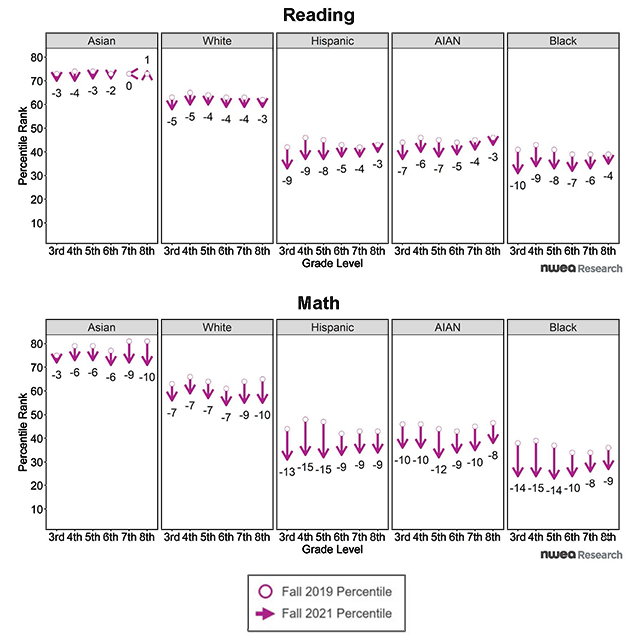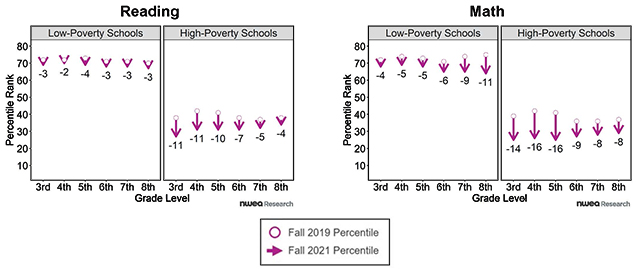Latest NWEA Data: COVID Impact Worse for Marginalized Students, High Poverty Schools
Research Shows Declines May Be Stabilizing, But Students Still Lagging, Especially in Math
- By Kristal Kuykendall
- 12/14/21
Nonprofit K–12 research firm NWEA on Tuesday released a new study that illustrates how the COVID-19 pandemic has disrupted student progress — and how it has disproportionately impacted students of color and students in high-poverty schools.
The report, “Learning During COVID-19: An Update on Student Achievement and Growth at the Start of the 2021-22 School Year,” is NWEA’s third study analyzing how the pandemic has affected student reading and mathematics outcomes.
The research shows student achievement at the beginning of the current school year at lower levels than typical years, with larger declines in math (a drop of 9–11 percentile points) than in reading (3–7 percentile points). While student achievement in every group lagged pre-pandemic norms, students in historically marginalized groups and in high-poverty schools show evidence of being impacted disproportionately more, particularly in grades 3–6, NWEA said.
To complete the study, researchers at NWEA compared Fall 2021 MAP Growth assessment scores from 6 million U.S. public school students in grades 3-8 to scores from students in the same grade in Fall 2019, the most recent semester unaffected by COVID-19. The data showed “significant levels of unfinished learning, particularly in math,” but NWEA noted that the numbers have not worsened since the end of the 2020-21 school year, indicating the impacts of the pandemic may be stabilizing.
Other Key Findings
-
Fall 2021 math and reading achievement levels continue to lag historical averages, with larger declines in math.
-
Student gains across the pandemic (from fall 2019 to fall 2021) lagged norms for pre-pandemic growth, especially in math.
-
Students with lower pre-pandemic achievement showed lower normative gains than high achievers.
-
Reading gains between fall 2019 and fall 2021 neared pre-pandemic growth rates; however, math gains were well below average.
Examining the Data
As shown in Figure 1, NWEA observed declines in fall 2021 achievement relative to fall 2019 ranging in magnitude from 3 to 7 percentile points in reading and 9 to 11 percentile points in math. These declines are larger than the declines observed in fall 2020 (when reading scores were approximately equivalent to a typical year and math scores were 5 to 10 percentile points lower) but are roughly consistent with those observed in NWEA’s spring 2021 study.

“These findings suggests that school-related disruptions continue to have a more significant impact on students’ acquisition of math skills/content compared to reading and highlights the need for continued focus on supporting the development of math skills,” NWEA said in its report.
Figure 2 shows differences in percentile rank between fall 2021 and fall 2019 grouped by student grade and race/ethnicity. While median achievement declined for nearly all groups in reading and math, with larger relative declines in math, the pattern of these decreases is uneven across student groups. “Specifically, Asian American and white students showed declines of a smaller magnitude relative to Hispanic, American Indian and Alaska Native (AIAN), and Black students,” NWEA stated in its report. “Consistent with our findings in the spring of 2021, we observed differences across race/ethnicity groups that are more pronounced for younger students, with the largest relative declines concentrated in the elementary grades.”

Figure 3 shows percentile-rank changes by school poverty level, illustrating that students in more economically disadvantaged schools were the most impacted by the pandemic, NWEA said. “This unequal impact is particularly evident in the elementary grades, where we saw declines for students in high-poverty schools that are notably larger than the declines for same-grade students in low-poverty schools,” the report stated.

NWEA said its data further illustrates the “inequitable nature of unfinished learning across the pandemic and shine light on the groups and subject areas that should be targeted for additional support as COVID recovery efforts continue in the 2021-22 school year and beyond.”
“This latest research highlights that while students are back in classrooms it does not mean that all is back to pre-pandemic ‘normal,’ even though there are early signs of some stabilization. The ongoing impact continues to disrupt learning and, especially, hit our most vulnerable students," said Chris Minnich, CEO of NWEA. "It is critical now more than ever that we direct funding where it is needed most and determine the necessary interventions to improve student outcomes, particularly for those who have suffered the greatest disruptions."
NWEA's research team is part of the "Road to Recovery" effort in collaboration with the American Institutes for Research and the Center for Education Policy Research at Harvard University, to help districts better target COVID-10 recovery programs toward student groups most impacted by pandemic learning disruptions.
The full research brief can be found online at NWEA’s website.